Dr. Randall Hughes FSU Coastal & Marine Lab
 A sure sign of spring for me is an increase in time in the field. (Robyn and Emily would probably disagree with me, since they have been out in the field regularly throughout the winter!) I have been in the lab or office since December, which feels like a long time, and I’m really looking forward to getting back in the field. I find it is so much easier to come up with new research questions and develop insights into what the animals and plants are doing out there when I’m actually there with them. I guess that makes sense!
A sure sign of spring for me is an increase in time in the field. (Robyn and Emily would probably disagree with me, since they have been out in the field regularly throughout the winter!) I have been in the lab or office since December, which feels like a long time, and I’m really looking forward to getting back in the field. I find it is so much easier to come up with new research questions and develop insights into what the animals and plants are doing out there when I’m actually there with them. I guess that makes sense!
So, what is going on in the field right now? The marsh is definitely responding to the recent warmer weather – the plants are “greening” and starting to grow faster.
And the animals are becoming more active.
On Friday, Robyn and I went out to retrieve minnow traps that she and Emily had set at Emily’s survey sites the day before. We didn’t catch many fish, but it wasn’t because they’re not there – rather, a strong wind prevented the tide from coming all the way into the marsh while the traps were out-
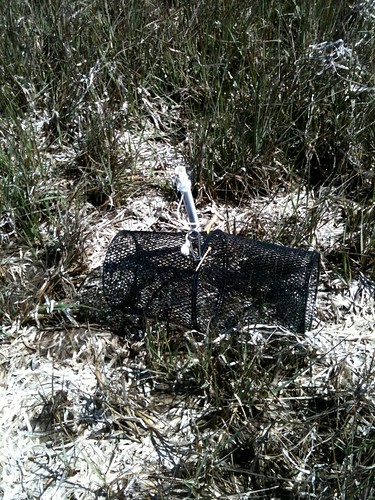
A minnow trap set in the marsh in St. Joseph Bay. The tide didn't come in high enough to submerge the traps for the 24 hours they were set.
-and it’s pretty hard to catch fish when you don’t have any water! We did get a few, though – mostly killifish – and some fiddler crabs.
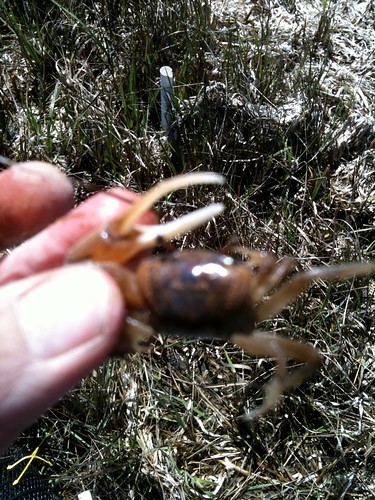
The minnow traps did effectively capture some fiddler crabs. (Apologies for the poor focus of my phone camera.)
While Robyn and I retrieved traps, Emily was busy completing her marsh surveys for the month of March. She had some special helpers this time – her parents! They came from Maine for a visit and were wonderful sports about being put to work, particularly given the windy and chilly weather. (They said they were just happy there was no snow!)
With all this increase in activity, it’s time to make plans for new studies and experiments for this summer. To clear some room in our calendar, we’re going to end the snail experiment that has been running for almost a year in St. Joe Bay. It has largely run its course – the cages with snails have very few live plants left in them, so there’s not much to take data on anymore! Still, I find the decision of when to end an experiment can be a challenging one, because you never know when something interesting is going to happen. We’ll sample the cages extensively in the next couple of weeks to make sure that the results we’re seeing aren’t changing with the change in season, and then it will be on to other projects!
What will those projects be? Some will be continuations of studies we started last summer, and some will be new –
1. Emily will continue her surveys of the effects of seagrass wrack on salt marsh plant and animal communities, and she’ll also begin some experiments to test hypotheses about why we see the patterns that we do.
2. We’ll do additional tank experiments to understand the single and combined effects of snails and grasshoppers on each other and the marsh plants they like to eat.
3. Althea, a first year graduate student in my lab, will start new experiments looking at the effects of mussels and fiddler crabs on marsh plants, to see whether two “friends” are better than just one.
4. We’ll begin field experiments to see whether some marsh plant individuals (or “genotypes”) are better habitat for snails, grasshoppers, etc., either because they are tastier to eat, or because they provide better protection from predators, or for some other reason.
Of course, there will also be lots of new research On the Reef, so it won’t be all marsh all the time! But I will leave it to David to fill you in on those comings and goings soon…
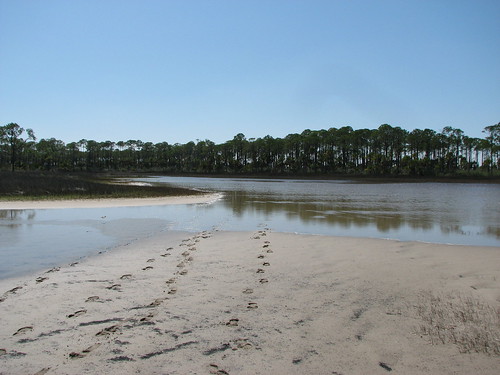

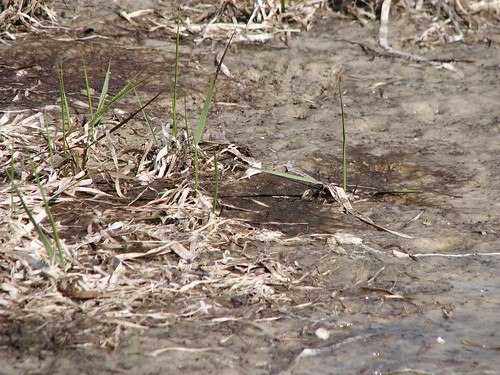
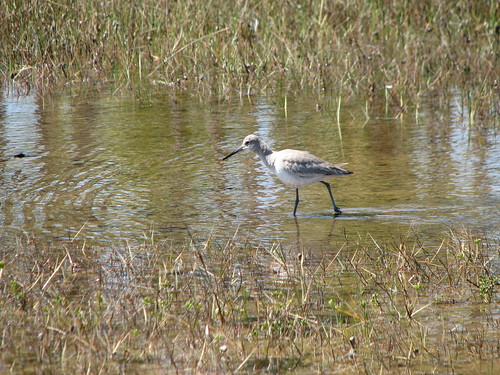

1 comment
We enjoyed helping Emily– learned a lot about the bay and had fun. But Ginny and I also learned that field research is hard work! Hats off to the researchers, lab techs, and grad students who do this.
Oh, and there’s still about 18 in of packed, icy snow cover in our yard at our home in Maine, and where the snow is gone it’s “mud season.”
Comments are closed.